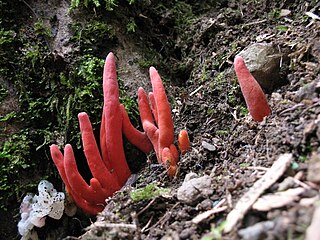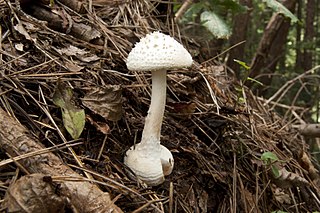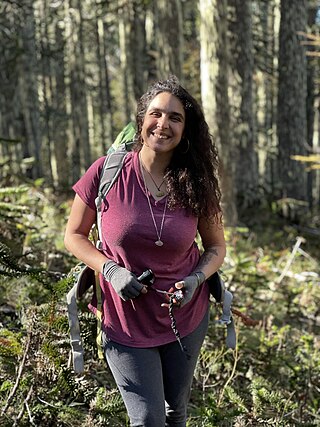The Mycological Society of America (MSA) is a learned society that serves as the professional organization of mycologists in the U.S. and Canada. It was founded in 1932. The Society's constitution states that "The purpose of the Society is to promote and advance the science of mycology and to foster and encourage research and education in mycology in all its aspects." Members of the MSA meet annually to exchange information and build understanding of fungi.

Tricholoma is a genus of fungus that contains many fairly fleshy white-spored gilled mushrooms which are found worldwide generally growing in woodlands. These are ectomycorrhizal fungi, existing in a symbiotic relationship with various species of coniferous or broad-leaved trees. The generic name derives from Ancient Greek: τριχο-, romanized: tricho-, lit. 'hair' and Ancient Greek: λῶμα, romanized: loma, lit. 'fringe, border' although only a few species have shaggy caps which fit this description.

Tylopilus is a genus of over 100 species of mycorrhizal bolete fungi separated from Boletus. Its best known member is the bitter bolete, the only species found in Europe. More species are found in North America, such as the edible species T. alboater. Australia is another continent where many species are found. All members of the genus form mycorrhizal relationships with trees. Members of the genus are distinguished by their pinkish pore surfaces.
Gastón Guzmán Huerta, a Mexican mycologist and anthropologist, was an authority on the genus Psilocybe.
Russula subnigricans, known as the rank russula, or Nise-Kurohatsu (Japanese), meaning "false blackening russula" is a basidiomycete mushroom of the genus Russula found in East Asia.

Tsuguo Hongo was a Japanese mycologist who specialized in the biogeography and taxonomy of Agaricales. Hongo entered the Department of Biology at what is now Hiroshima University in 1943, where he studied botany until graduating in 1946 with a B.Sc. Hongo received his Ph.D. degree, entitled "Agaricales of Japan", from Kyoto University in 1961 while working under Dr. Shiro Kitamura.

Lactifluus volemus, formerly known as Lactarius volemus, and commonly known as the weeping milk cap or bradley, is a species of fungus in the family Russulaceae. It is widely distributed in the northern hemisphere, in temperate regions of Europe, North America and Asia as well as some subtropical and tropical regions of Central America and Asia. A mycorrhizal fungus, its fruit bodies grow on the ground at the base of various species of trees from summer to autumn, either individually or in groups. It is valued as an edible mushroom, and is sold in markets in Asia. Several other Lactifluus mushrooms resemble L. volemus, such as the closely related edible species L. corrugis, but these can be distinguished by differences in distribution, visible morphology, and microscopic characteristics. L. volemus produces a white spore print and has roughly spherical spores about 7–8 micrometres in diameter.

Boletellus obscurecoccineus, known as the rhubarb bolete, is a species of fungus in the family Boletaceae, found in Australia, New Guinea, Java, Borneo, Japan, Korea, and Taiwan. It is a distinctive and colourful bolete of the forest floor.
Ammonia fungi are fungi that develop fruit bodies exclusively or relatively abundantly on soil that has had ammonia or other nitrogen-containing materials added. The nitrogen materials react as bases by themselves, or after decomposition. The addition of ammonia or urea causes numerous chemical and biological changes, for examples, the pH of soil litter is increased to 8–10; the high alkaline conditions interrupts the process of nutrient recycling. The mechanisms of colonization, establishment, and occurrence of fruiting bodies of ammonia fungi has been researched in the field and the laboratory.

Podostroma cornu-damae, also known as the poison fire coral, is a species of fungus in the family Hypocreaceae. The fruit bodies of the fungus are highly toxic, and have been responsible for several fatalities in Japan. The fungus contains several trichothecene mycotoxins.
Silvia N. Blumenfeld is an expert on mycology. From 1986 to 2004, she was a Professor of Mycology and Biotechnology of Filamentous Fungi at the National University of Comahue, in Río Negro, Argentina. She emigrated to Israel in 2002, where she became the curator of the Tel Aviv University fungi collection, specializing in medicinal mushrooms. She has over 50 articles, books, and patents to her name, and has received academic honours. In 1995, she was awarded the Argentine National 'José Antonio Balseiro' Prize for her work.

Amanita sphaerobulbosa, commonly known as the Asian abrupt-bulbed Lepidella, is a species of agaric fungus in the family Amanitaceae. First described by mycologist Tsuguo Hongo in 1969, it is found in Southern Asia.
Teófilo Herrera Suárez was a Mexican mycologist who was known for his contributions to the Mexican mycological flora. He was also an emeritus professor at the National Autonomous University of Mexico (UNAM), where he worked for over 50 years.
Tylopilus rigens is a bolete fungus in the family Boletaceae. Found in Japan, it was described as new to science in 1979 by Tsuguo Hongo.

Parvixerocomus aokii is a species of bolete fungus in the family Boletaceae. It was originally described by Japanese mycologist Tsuguo Hongo in 1984 as a species of Boletus. Chinese mycologists Gang Wu, Nian-Kai Zeng, and Zhu L. Yang transferred it to Parvixerocomus in 2015. It is known only from China and Japan, where it grows in tropical and subtropical forests with trees of the family Fagaceae.
Egon Horak is an Austrian mycologist who has described more than 1000 species of fungi, including many from the Southern Hemisphere, particularly New Zealand and South America. He was an executive editor of the scientific journal Sydowia from 1975 to 1989, and a member of the editorial board afterwards.

Pseudoaustroboletus is a fungal genus in the family Boletaceae. The genus is monotypic, containing the single species Pseudoaustroboletus valens, found in China, Japan, Malaysia and Singapore. It was originally given the name Boletus albellus illegitimately based on specimens from Singapore by George Edward Massee in 1909. In 1972 it was given the name Boletus valens legitimately before being transferred to Tylopilus valens in 1976. A molecular phylogenetics study found it to be distinct from Tylopilus and Boletus and the authors placed it in its own genus, Pseudoaustroboletus.

Giuliana Furci OSI is a field mycologist, speaker, author, and founder and CEO of the Fungi Foundation. She is a Harvard University associate, National Geographic Explorer, Dame of the Order of the Star of Italy, deputy chair of the IUCN Fungal Conservation Committee, and author of several titles including a series of field guides to Chilean fungi and co-author of titles such as the 1st State of the World's Fungi and the publication delimiting the term “funga” and the 3F Proposal - Fauna, Flora & Funga. Giuliana has held consulting positions in U.S. philanthropic foundations as well as full-time positions in international and Chilean marine conservation non-profits. She sits on the Board of Fundación Acción Fauna, and on the advisory board of the Society for the Protection of Underground Networks (SPUN), and other organizations. Giuliana has received several distinctions including the 2022 Buffett/National Geographic Leadership in Conservation in Latin America Award, 2022 Gordon and Tina Wasson Award from the Mycological Society of America, and the 2013 Presidents Award from the International Society for Fungal Conservation.









